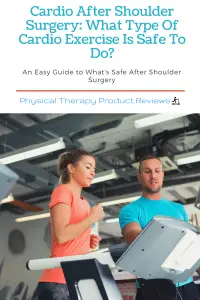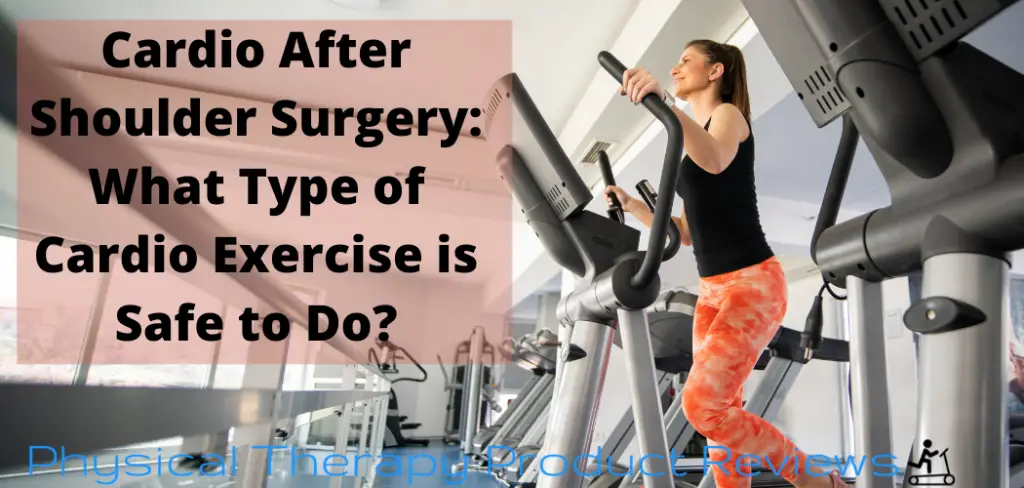Cardiovascular exercises are an important part of a healthy lifestyle. After shoulder surgery, cardio exercise can be safe and beneficial for your recovery if done properly. These types of cardio exercises include: riding a stationary bike, walking, running, swimming, stair climbers, and elliptical machines.
However, it is always advised to wait until certain points in the recovery before attempting the more involved exercises. This post will cover what type of cardiovascular exercise is safe to do after surgery and when it is safe to progress to the more involved types of exercises after shoulder surgery.
Can You Perform Cardio Exercise After Shoulder Surgery?
 Yes. Cardiovascular exercise is safe provided that the cardio machine does not cause pain or discomfort in your shoulder, and you can maintain proper form on the cardio machine.
Yes. Cardiovascular exercise is safe provided that the cardio machine does not cause pain or discomfort in your shoulder, and you can maintain proper form on the cardio machine.
You can start walking as soon as the next day after surgery in most cases, although make sure you don’t overdo it but walking too far.
Cardio exercise is one of the best things that you can do to speed up the healing process after shoulder surgery. It helps prevent blood blots after surgery, promotes good blow flow, helps with pain control, and even reduces overall muscle tightness.
Is it Better to Start Cardio Exercise After Shoulder Surgery or Wait to Play is Safe?
It is generally recommended to start cardio exercise if you are healthy, as soon after shoulder surgery as you feel able.
Cardiovascular exercise is a great way to speed up healing, help with mental stress and anxiety, maintain weight, help mitigate inflammation, and reduced pain levels throughout the whole body.
Be sure to take it slow and follow any recommendations that your surgeon gives you.
What Cardio Exercise Can you Do Right After Surgery?
You can start cardio exercise as soon as the day after surgery in most cases. However, to avoid injury you should not overdo it at first.
If your doctor says that cardio exercise is okay then you can do some light walking or stationary cycling on a bike without resistance for 20 minutes a few times a day. Make sure when doing this activity that you don’t have any pain or discomfort in your shoulder.

Make sure that you can get on and off the bike without injuring your shoulder and can do it with your sling on.
During the first 2 weeks after shoulder surgery, we recommend walking outside or on a treadmill and using a stationary bike if you can do it pain-free.
Timeline of When You can Return to Cardiovascular Exercise After Shoulder Surgery
The recommendations in this post apply to rotator cuff repair, shoulder labral repair, and total shoulder replacements. There may be some surgeries that you can return to cardiovascular exercise sooner and some that you may have to wait a little longer. We’ve intentionally erred on the side of caution just in case.
Listed below is a general timeline that you can use on when you can start to perform different cardio exercises:
Disclaimer: This is for Informational purposes only. Please consult and get clearance from your surgeon before starting any new cardiovascular exercise.
| Type of Cardio Exercise | Time After Surgery |
|---|---|
| Walking | Immediately after surgery |
| Biking | Stationary Bike - Immediately after surgery, Road-Biking - 12-14 weeks or later after surgery, Mountain Biking - 5-7 months after shoulder surgery |
| Running | 12- 14 weeks after surgery |
| Elliptical | 12- 14 weeks after surgery |
| Stair Climber | 14-16 weeks |
| Rowing Machine | 6 months or greater after surgery |
| Swimming | 6 months or greater after surgery |
FAQ About Cardio Exercise After Shoulder Surgery
You can walk right after surgery. Make sure to take it slow and easy for the first day or two while walking around. You might feel unsteady due to the anesthesia and pain medication that you are taking after the surgery.
This can have an effect on your balance and the last thing you want to do is fall on the newly repaired shoulder. Make sure that your shoulder brace is one and in the right position.
You can start to run after 12-14 weeks. If you had a Rotator Cuff Repair surgery or shoulder stabilization surgery, then this is the earliest that it would be safe for you to do cardio exercise like running.
Start at a combination of walking and running at a 45 seconds:45 seconds ratio to get started. You can slowly increase the talking running if this goes well.
At this point you will no longer be wearing a shoulder sling.
Swimming is safe to do 6 months or greater after shoulder surgery. You might be able to return to swimming sooner with certain strokes such as the breaststroke or simply kicking with a paddle.
With a return to full swimming make sure that your shoulder is strong enough and start with a gradual return. No more than about 10-15 minutes the first time and gradually increase the time by 15%. If there is any pain stop and wait for another week before trying again.
You can use a stationary bike after shoulder surgery right away. Just go easy and don't overdo it the first few times you ride a stationary bicycle. Be sure to keep your shoulder sling on.
Start with 20 minutes on level one or two initially and gradually work your way up to 30-45 minutes of cardio exercise at level four within 12 weeks if there is no pain or discomfort during your cardio.
You can begin road biking at around 12-14 weeks post surgery as long as your shoulder can tolerate the pressure through the arms.
Mountain biking takes quite a bit longer until the shoulder is ready. Plan on 5-7 months after surgery before the shoulder is strong enough.
An elliptical is a cardio machine that you can use 12-14 weeks after shoulder surgery. If you have had a total shoulder replacement you can likely start this at 10 weeks post-surgery.
It does put just enough stress on the shoulder for a rotator cuff repair that it's best to hold off and do other types of exercise while the surgery heals.
Also, it's easy on your lower back as well, which makes it good for people who have had previous spine problems such as degenerative disc disease.
You can use the stair climber after shoulder surgery. However, go slow and easy to start with while you are recovering from your injury or surgery.
Start out at a low speed when you first start at 12 weeks post-op. If there is no pain during cardio exercise on this machine gradually work up to 20 minutes of cardio at a comfortable pace.
You can use the rowing machine after shoulder surgery. However, go easy and don't overdo it for your first few cardio exercise sessions on this machine
Start at a low resistance of level one or two at 12 weeks post-op. Start at 5-10 minutes of exercise initially. You can gradually work up to 20 minutes of cardio over the next few weeks. If there is no issue you can begin to progress to normal exercise levels.
What are the Benefits of Cardiovascular Exercises after Shoulder Surgery?
Cardio exercises are beneficial in a number of different ways after any surgery. The nice thing about shoulder surgery is that you often get to start sooner than other surgeries because your legs aren’t involved with the surgery.
- It helps to reduce pain and stiffness in your shoulder by promoting blood flow
- It strengthens the muscles around the shoulder and upper back which can help prevent future injuries
- It can help normal scar tissue form and aid in preventing initial adhesions that can form after surgery
- Cardio exercise can help you to get back into shape and lose weight faster after surgery
- It can help with mood and overall outlook after surgery
- Cardio exercise can help improve sleep and reduce pain at night time
Do you not have access to any cardio equipment? Don’t worry, we’ve created a guide to the best treadmills under $300 so that you don’t have to break the bank to get a workout in.
What's the Risk of Cardio Exercise after Surgery?
The biggest risk of performing cardio exercises after shoulder surgery is re-injuring the surgical area. This can happen if you use your arm too early in the recovery process or you simply trip and fall while you getting onto or using a piece of cardio equipment.
For example, if you swim too hard too soon after surgery, it can cause extra stress on your shoulder joints and the rotator cuff muscles from doing a stroke such as freestyle or breaststroke.
Some helpful tips to know if you are performing activities sooner or for a longer duration than you should:
- You have pain during and after activity
- You start to have muscle spasms while doing the activity
- Your shoulder starts to swell during and after the activity
If you experience any of these drop the intensity and the time you are performing the activity in half and slowly build up from there based on tolerance.
If you are at all worried please consult with a medical professional regarding your exact situation.
Tips for Exercising Immediately After Surgery
The best-case scenario for cardio exercise after shoulder surgery is to get a good workout without injuring the shoulder.
Some helpful tips for exercise immediately after surgery include:
- Wear your sling during all cardio exercises
- Be sure to start small – even at only 5 minutes the first few times that you exercise to make sure that the shoulder can tolerate it
- Be extra cautious getting on and off the exercise equipment – this is when most falls happen with exercise
- Try to avoid using your shoulder muscles at all during the cardio exercise – focus on turning the muscles off
- Think about posture – avoid slouching or resting the arm on anything which can result in unknown use of the arm
The general rule for cardio exercise after shoulder surgery is to avoid it until you are cleared by your medical professional.
Conclusion
The intent of this article is to review what cardio exercise is safe to do after shoulder surgery. This includes riding a stationary bike, walking, running, swimming, stair climber, and elliptical machines.
If you are at all worried or experience any pain please consult with your medical professional for advice regarding your exact situation, don’t push through pain. If there is no pain, cardio exercise can help reduce pain and stiffness in your shoulder, strengthen the muscles around the shoulder and upper back, aid with scar tissue formation, improve mood, sleep quality.
Other Great Rehab Related Articles
Dealing with Painful Stairs After Ankle Replacement Surgery
Walking After a Total Ankle Replacement: Tips for a Successful Recovery
Exercises While Non-Weight Bearing After Ankle Replacement: Elevation, AROM, Leg Raises, and More
Ankle Pain with Stairs: Causes and Home Treatment Options
5 Common Mistakes You’re Making After an Ankle Sprain
6 Great Ways to Reduce Low Back Pain with Driving
Disclaimer: The information provided in this post is for educational purposes only. This is not a substitute for a medical appointment. Please refer to your physician before starting any exercise program.






